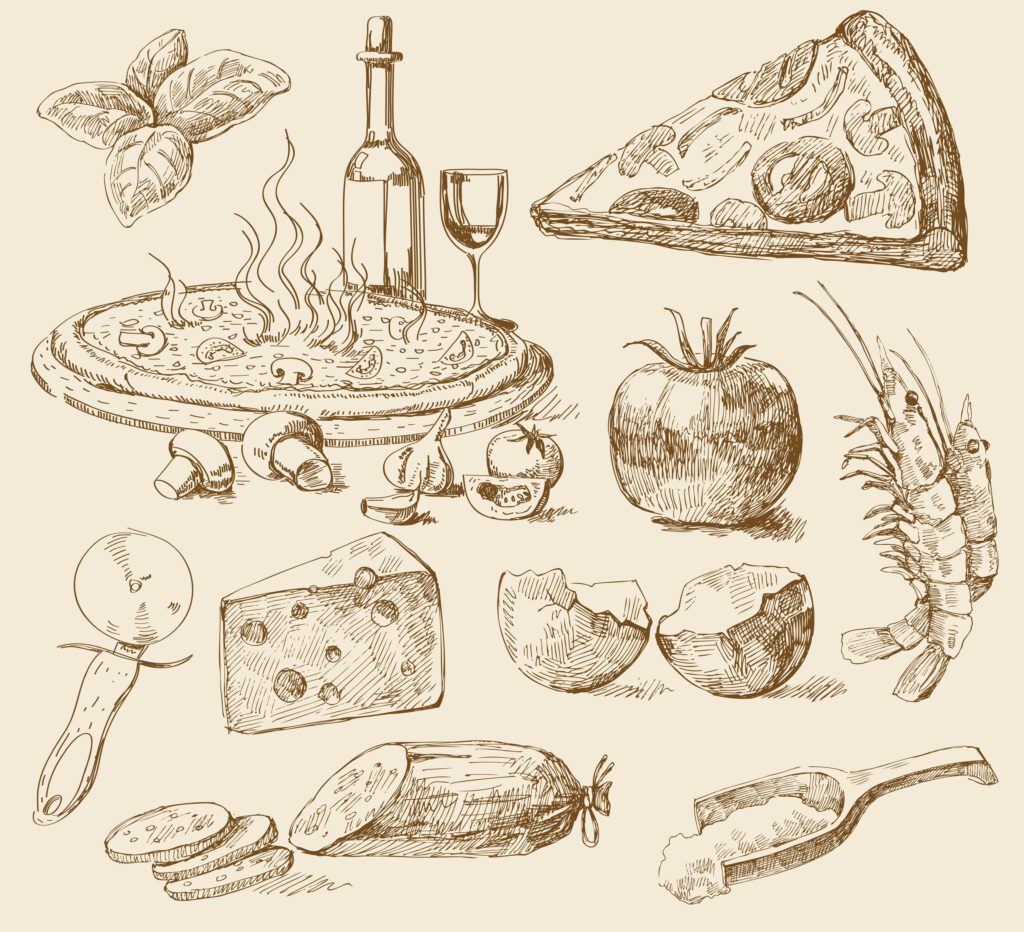Welcome to Ferlito’s.
At our table, we believe that the heart of Italian cuisine lies in its simplicity and quality ingredients. We love a meal where dishes are infused with the vibrant flavors of northern Italy.
Our menu features all kinds of fresh pasta, savory tomato sauces, creamy risottos, perfectly baked pizzas straight from a wood-fired oven, seafood like shrimp Portofino, and tender meats like veal piccata and smoked gouda bbq chicken, all seasoned with aromatic herbs and spices. We only serve food to our guests that we would serve to our families!
As you explore the essence of Italian cooking, you’ll discover how ingredients like wild mushrooms, roasted peppers, and fresh vegetables transform everyday meals into something extraordinary. For now, you can tag along with us as we explore the joys of cooking with love and savoring Italy’s fresh flavors, one bite at a time!

Staple Ingredients in the Italian Pantry
If you’ve ever stepped into an Italian kitchen, you’ll be greeted with the warm aroma of olive oil and garlic sizzling in a pan. These two ingredients are the foundation of many Italian dishes. We’ve compiled a list of must-have ingredients for an Italian pantry to help you create authentic meals at home.
With a kitchen full of these ingredients, you can quickly whip up classic Italian dishes for any craving!

Olive Oil: Liquid Gold
Olive oil is an essential ingredient in any Italian pantry, known for its versatility and rich flavor. Here’s a breakdown of its types and its role in Italian cooking:
- Extra Virgin Olive Oil: Made from the first pressing of olives, EVOO boasts a rich flavor and is perfect for drizzling over dishes. We love it for finishing salads, pasta, and dips, adding a touch of sophistication to any meal!
- Virgin Olive Oil: Slightly lower in quality than extra virgin, this oil is still great for sautéing and cooking at moderate temperatures. Generally, people use it in everyday recipes where a more subtle olive taste is desired.
- Light Olive Oil: This refined olive oil has a lighter taste, suitable for baking and frying without overpowering the dish. Light olive oil is great for special events where you want to maintain balance in the flavors you present, like in delicate pastry recipes or lighter sauces.
The Role of Olive Oil in Italian Cooking
Olive oil is often used as a base for sauces and dressings, enhancing the taste of almost every flavor it touches, from fresh herbs to garlic. It pairs beautifully with flavors like roasted peppers and wild mushrooms.
This multipurpose ingredient is essential for preparing everything from risotto made with rice and seasonal vegetables to hearty pasta sauces that showcase tomatoes and meat, like chicken or pork sausage. It contributes to the perfect crust on pizzas baked in a wood-fired oven and imparts depth to soups and stews.
All these reasons are why it’s at the top of our list!

Garlic: The Aromatic Bulb
Garlic is the aromatic cornerstone of Italian food, particularly Southern Italian cuisine, infusing dishes with its distinct and robust flavor. When you’re cooking up a classic pasta dish or preparing a hearty risotto, garlic almost always plays a starring role.
Versatility in Italian Dishes
Garlic’s versatility knows no bounds—it’s essential in so many variations of Italian foods. You’ll find it taking a lead in tomato-based sauces, where it melds beautifully with the sweetness of tomatoes and the richness of olive oil. In the region of Emilia Romagna, for instance, this aromatic bulb helps elevate the taste of traditional dishes like lasagna and even has it’s own DOP certified garlic!
For a simple yet delicious pasta recipe, consider aglio e olio, which highlights the pure beauty of garlic sautéed in olive oil and tossed with spaghetti. Another trick to remember is that garlic adds a burst of flavor to seafood pastas when paired with white wine, complementing the delicacy of fish and shellfish.
Preparing Garlic for Maximum Flavor
To get the most out of this main ingredient, preparation is critical.
Crushing or mincing garlic releases its oils and intensifies its flavor. Crushed and minced garlic are perfect additions to sauces, marinades, and rubs for meats like chicken and beef. Roasting garlic mellows its sharpness, bringing out a sweet, buttery taste that’s fantastic when spread on bread or mixed into mashed potatoes.
When it comes to special events or a casual dinner, a garlic-infused dish can make your meal memorable for all your guests! Any chef can use garlic to enhance everything from cooked vegetables, like roasted peppers and onions, to baked pizzas, served sizzling hot from the oven.
Garlic isn’t just a powerhouse of flavor; it’s also incredibly easy to use, making it a staple in every Italian kitchen. Finely chop for a quick sauté or add whole cloves to a stew to mellow and enrich the broth; garlic’s presence is indispensable in Italian recipes.
Remember the humble garlic bulb next time you’re preparing an Italian meal. It’s not just a spice but an essential component that brings out the best in your dishes, enriching them with deep, aromatic flavors.

Fresh Basil: The Fragrant Herb
Fresh basil is the green jewel of Italian cuisine, bringing a burst of aroma and flavor to countless dishes.
This vibrant herb is a main ingredient in iconic recipes like pesto, where it’s blended with garlic, Parmesan cheese, pine nuts, and olive oil to create a sauce perfect for pasta or a spread on bruschetta. Basil also steals the show in the classic Caprese salad, complementing the ripe tomatoes, fresh Mozzarella, and drizzle of balsamic vinegar.
Using Fresh vs. Dried Basil
When it comes to cooking, the choice between fresh and dried basil can significantly impact your meal’s flavor.
Fresh basil leaves, with their intense fragrance and bright taste, are best used in dishes that require minimal cooking, like salads, pizzas, or a garnish for pasta. For instance, that simple spaghetti aglio e olio we mentioned earlier gets an aromatic lift with fresh basil added just before serving.
While not as fragrant as its fresh counterpart, dried basil is a handy pantry staple that infuses a warm, slightly peppery flavor into cooked foods. It’s perfect for sauces and soups that simmer for a long time, allowing the basil’s essence to meld with other seasonings. When cooking a hearty tomato marinara or beef stew, adding dried basil early in the process helps deepen the dish’s overall taste.
Tips on Preparing and Storing Basil
To make the most of fresh basil, it’s important to handle it with care. Tear the leaves by hand or slice them into thin strips (chiffonade) to prevent bruising and preserve their vibrant green color. If you’re preparing a large meal for special events, consider incorporating basil into stuffed peppers, mixed into a creamy risotto, or sprinkled over a lemon and herb-baked fish dish.
Storage is key to keeping basil fresh. Place the stems in a glass of water and cover the leaves loosely with a plastic bag, storing them on the countertop, not in the fridge. This way, you’ll always have fresh basil ready to elevate your dishes, from a simple basil and garlic pasta to a savory chicken and basil stir-fry.
Incorporating basil into your cooking enhances the flavor profile and adds a touch of Italy’s culinary magic to your kitchen. Whether you use it fresh or dried, this fragrant herb is a staple in Italian recipes, bringing a delightful aroma and a taste of the Mediterranean to each bite.

Tomatoes: The Juicy Staple
In Italian cooking, tomatoes are a cornerstone ingredient that brings a burst of flavor to a myriad of dishes. Whether using Roma, San Marzano, or another variety, tomatoes are indispensable in creating hearty, rich sauces and soups Iconic to Italian cuisine.
The sweetness of a perfectly ripe tomato can elevate everything from a simple pasta dish to a sophisticated veal recipe!
The Importance of Different Tomato Varieties
The type of tomato you choose can make a big difference in your meal. Roma tomatoes are often preferred for sauces because they contain less water and more flesh, which results in a thicker, more concentrated sauce.
San Marzano tomatoes, prized for their sweet taste and low acidity, are the gold standard for other authentic Italian recipes. These tomatoes are often used in marinara sauces, giving them that rich and unmistakable depth.
The Role of the Tomato in Sauces, Soups, and Salads
Tomatoes are incredibly versatile and can be used in a variety of ways.
For instance, in a classic marinara sauce, Roma tomatoes meld beautifully with garlic, olive oil, and seasonings to create a robust and flavorful dish. However, when preparing a vibrant tomato soup, San Marzano tomatoes will perfectly balance sweetness and acidity, making every spoonful a delight.
In salads, fresh tomatoes shine, especially in the beloved Caprese salad. This simple but flavorful dish features ripe tomatoes, fresh mozzarella cheese, and fragrant basil, all drizzled with olive oil and balsamic vinegar. It’s a dish that embodies the fresh, uncomplicated charm of Italian eating.
Even in special events, tomatoes find their place—think about a stuffed pepper dish, where tomatoes blend with rice, meat, and spices to create a delightful and hearty entrée. And let’s not forget how they enhance pizzas, adding a juicy layer of flavor that complements an array of toppings from spicy peppers to savory sausages. What would pizza even be without the beloved tomatoes?!
When you’re cooking up a storm for a special dinner (or just preparing a casual weeknight meal), remember that tomatoes are your best friend in the kitchen. They add a splash of color, a burst of juice, and an unmistakable Italian flair to any dish they touch.

Pasta: The Heart of Italian Cuisine
Pasta is perhaps the most beloved and iconic element of Italian cuisine, offering a versatile canvas for a variety of delicious dishes. With an array of types, each suited to different recipes and sauces, pasta remains central to Italian cooking.
From classic spaghetti to more intricate shapes like orecchiette and farfalle, understanding the perfect pairings can elevate your culinary creations.
Various Types of Pasta and Their Ideal Sauce Pairings
Different pasta shapes complement different sauces in unique ways.
- Long, thin strands like spaghetti work wonderfully with light, olive oil-based sauces or seafood dishes, allowing the pasta to absorb the delicate flavors.
- Thicker pasta like rigatoni or penne is perfect for hearty meat sauces, such as a robust Bolognese or sausage ragu, where the ridges catch every morsel of the savory sauce.
- Egg-based pasta like tagliatelle pairs exquisitely with creamy, rich sauces. Tagliatelle alfredo, or a comforting carbonara made with eggs, cheese, pancetta, and a dash of black pepper, are perfect examples.
- Pasta shapes with curves and ridges, such as fusilli or farfalle, are great for thick sauces that can cling to the pasta’s surface, like a hearty tomato basil sauce or a pesto made with pine nuts, lemon juice, garlic, salt, pepper, basil leaves, EVOO, and freshly grated parmesan cheese.
Tips For Pasta Perfection
Cooking pasta to perfection is an art that requires attention to detail.
- Start by bringing a large pot of salted water—roughly one tablespoon of salt per liter of water- to a boil. This ensures the pasta is seasoned as it cooks.
- Once the water is boiling, add the pasta and stir gently to prevent it from sticking together.
- Cook the pasta for a minute below the package’s suggested cooking time; this will ensure that the pasta remains al dente or firm to bite. This texture not only provides the ideal bite but also allows the pasta to absorb the sauce better!
- Once cooked, reserve a cup of the pasta water before draining. This starchy water can help loosen sauces and make them cling perfectly to the pasta.
- Finally, toss your perfectly cooked pasta with your desired sauce and enjoy!
Whether you’re preparing a classic spaghetti Bolognese, delicate seafood linguine, or creamy fettuccine Alfredo, following these simple tips will result in perfect pasta every time.
Special Event Dishes Featuring Pasta
Pasta is versatile enough to shine in both everyday meals and special events.
Preparing a sumptuous seafood pasta, such as spaghetti alle vongole, infused with white wine, garlic, and fresh clams, is perfect for a sophisticated dinner party. Another elegant option is a rich lobster linguine, where the delicate flavors of lobster meld perfectly with a tomato and white wine sauce.
Lasagna is a crowd-pleaser for heartier fare, with layers of pasta, béchamel, meat sauce, and cheese, all baked to perfection. Even risotto, while not strictly pasta, deserves mention for its creamy texture and toothsome grains of rice. A saffron-infused risotto alla milanese, often served alongside osso buco, is a classic choice that embodies the luxury of Italian special event meals.
Italian cuisine’s beauty lies in its simplicity and the way each ingredient is celebrated. Pasta, as a main ingredient, embodies this philosophy, offering endless possibilities to delight your palate. No special occasion necessary, a weekday dinner or a grand feast, pasta dishes promise to deliver taste, satisfaction, and a true glimpse into Italy’s culinary heritage.

Cheese: The Creamy Accent
Does Italian food even exist without cheese?
Cheese is indispensable in Italian cuisine, adding a creamy, flavorful accent that elevates any dish. With a vast array of cheeses, each with its unique flavor profile and texture, cheese is an ingredient that can make or break a dish.
The Essentials: Parmesan, Mozzarella, and Ricotta
Parmesan, Mozzarella, and Ricotta are among the most essential cheeses in the Italian culinary repertoire.
- Parmesan: often aged for 12 months or more, parmesan cheese boasts a nutty flavor and grainy texture, making it perfect for grating over pasta or risotto.
- Mozzarella: Whether you serve fresh Mozzarella in thin slices alongside ripe tomatoes and basil in a Caprese salad or melted on a Neapolitan pizza, this staple offers a milky, stretchy texture that is beloved worldwide.
- Ricotta: A creamy cheese made from whey, Ricotta is used in both savory dishes like lasagna and sweet treats such as cannoli, embodying the versatility and richness Italian cheeses bring to the table.
How Cheese Enhances the Taste and Texture of Dishes
Cheese not only adds complexity to the flavor profile of various foods but also contributes to the creaminess and richness that make Italian dishes so comforting.
A sprinkle of finely grated Parmesan can turn a simple plate of spaghetti into a culinary delight, while melted Mozzarella on a Margherita pizza creates a perfect, gooey layer that complements the tomato sauce and herbs.
Ricotta is often used to lighten the texture of recipes, such as in stuffed pastas like ravioli or cannelloni, where it melds seamlessly with spinach, meat, and spices. In baked dishes, Ricotta browns beautifully to create a crispy, golden crust, enhancing the taste and visual appeal of foods. Special event dishes, like a lavish cheese-stuffed chicken breast cooked in white wine, showcase how integral cheese is, transforming everyday ingredients into gourmet meals.
Cheese also helps balance the flavors in recipes with more intense ingredients like garlic, onions, and spicy meats like pork and veal. It’s no wonder that Italian chefs hold cheese in such high regard, considering its ability to harmonize the diverse elements often found in Italian cooking!
Cheese can make all the difference in a dish. It’s a quintessential main ingredient in Italian cuisine, celebrated for its ability to enhance the taste and texture of a wide array of meals, from casual weeknight dinners to sophisticated special events.

The Role of These Staple Ingredients in Italian Cuisine
The ingredients we’ve touched on are far from an exhaustive list of the staples used in Italian cuisine. Still, they illustrate how these essential elements play a fundamental role in elevating dishes from ordinary to extraordinary.
Italian cuisine thrives on the harmonious interplay of its main ingredients, each bringing its own unique qualities to the table.
The richness of cheese perfectly complements the acidity of tomato-based sauces, creating a balanced flavor profile that is as comforting as it is delicious.
Fresh herbs like basil and parsley add a burst of green freshness, cutting through the heaviness of meats like beef and pork.
The texture of pasta, whether al dente or creamy, is an ideal vehicle for capturing the flavors of these ingredients, ensuring each bite is a delightful experience.
The Traditional and Modern Uses of These Ingredients in Regional Dishes
Traditionally, Italian cuisine has focused on simple, regional dishes that highlight the natural flavors of the ingredients.
In the countryside, robust dishes featuring pork, olives, and onions have been staples for generations. Rich red wines are used to deglaze pans and intensify the depth of sauces, while lemon provides a zesty contrast in creamy chicken dishes.
Modern interpretations continue to honor these traditions but often introduce contemporary twists, such as using red wine reductions in sauces or incorporating unconventional ingredients into traditional dishes. These modern takes on classic recipes add a touch of innovation while still preserving the essence and authenticity of Italian cuisine.
The Importance of Balance and Simplicity in Italian Cooking
Italian cooking celebrates the philosophy of balance and simplicity. The emphasis is on using fresh, high-quality ingredients that require minimal preparation to shine.
For instance, a simple Margherita pizza involves just flour, yeast, tomatoes, Mozzarella, and basil, yet this favorite achieves a perfect balance of flavors. Chefs understand that restraint is vital, allowing each ingredient to contribute to the overall dish without overpowering the others. The use of spices and herbs is judicious, ensuring that the intrinsic flavors of the main ingredients are enhanced rather than masked.
Italian cuisine’s success lies in transforming straightforward ingredients into culinary masterpieces. Whether it’s the creamy decadence of a risotto made with Arborio rice and a dash of butter or a piece of fish prepared with olives and a touch of lemon, the goal is always the same: to create dishes that are both simple and sublime. In this way, Italian cooking remains a testament to the art of culinary balance and the celebration of natural, authentic flavors.

Tips for Selecting Quality Ingredients
The quality of your ingredients is crucial to the success of your dish.
Selecting Fresh vs. Canned Tomatoes
When it comes to tomatoes, both fresh and canned have their roles in Italian cooking. Fresh tomatoes are ideal for raw applications such as Caprese salads, where their natural sweetness can shine. Canned tomatoes, particularly the San Marzano variety, are perfect for slow-cooked sauces as they develop deeper flavors.
A discerning chef knows proper selection can elevate a simple tomato-based recipe into a culinary masterpiece.
Selecting the Best Cuts of Meat
When selecting meats like chicken or pork, make sure they are free-range and hormone-free. This ensures better flavor and aligns with the traditional Italian philosophy of using natural, minimally processed ingredients. Also, consider purchasing from local farmers or butchers, as they often have superior quality meats and can provide information about the source of their products.
The Significance of Sourcing Local and Organic Herbs
Using fresh, local, and preferably organic herbs can dramatically improve the taste of your dish.
Basil, parsley, oregano, and rosemary are staples in many Italian recipes, like pesto and marinades for meat and fish. These herbs should be vibrant in color and free of any wilting. Organic herbs ensure the absence of harmful pesticides and provide a more intense aroma and flavor.
Recognizing Authentic Italian Cheese and Pasta Brands
Quality cheese and pasta are fundamental to Italian cuisine.
Authentic Italian cheeses like Parmigiano-Reggiano and Pecorino Romano bear specific designations like DOP (Denominazione di Origine Protetta), ensuring they are made under strict regulations in certain regions of Italy. This guarantees their flavor and texture are aligned with traditional standards.
Similarly, opting for pasta brands like De Cecco and Barilla, known for their adherence to traditional production methods, ensures quality and authenticity in your dishes.
By selecting quality ingredients, you are honoring the rich heritage of Italian cuisine and guaranteeing a delicious and authentic dining experience.

Embrace the Art of Italian Cooking
The magic of Italian cuisine lies in its ability to transform simple, high-quality ingredients into extraordinary culinary experiences. By focusing on balance, simplicity, and the harmonious interplay of flavors, Italian cooking continues to captivate and inspire.
Whether you’re preparing a traditional regional dish or experimenting with modern twists, the importance of selecting quality ingredients can’t be overstated. Embrace the art of Italian cooking and create meals that are not only delicious but also a celebration of authentic, natural flavors. Buon appetite!
Ferlito’s Italian Restaurant: Bringing Authenticity to Your Table
At Ferlito’s Italian Restaurant, authenticity is at the heart of our culinary philosophy.
We meticulously source our main ingredients from trusted suppliers who share our commitment to quality. We source as much of our meats and produce locally as possible, supporting our community’s farmers and ensuring the freshest ingredients. We also try to keep sustainability in mind by using organic ingredients whenever available.
Our skilled chefs understand the importance of balance and simplicity in Italian cooking, crafting each dish carefully to showcase our ingredients’ natural flavors.
Join Us Whenever You’re Craving Italian Food!
Ready to experience the authentic flavors of Italy? Come join us at Ferlito’s!
We’ve got something to tantalize every palate. Our chefs pour their heart and soul into every dish to ensure your meal is nothing short of extraordinary. So, bring your friends and family, or come solo, and let’s make mealtime special.
We can’t wait to see you – Buon appetite!
